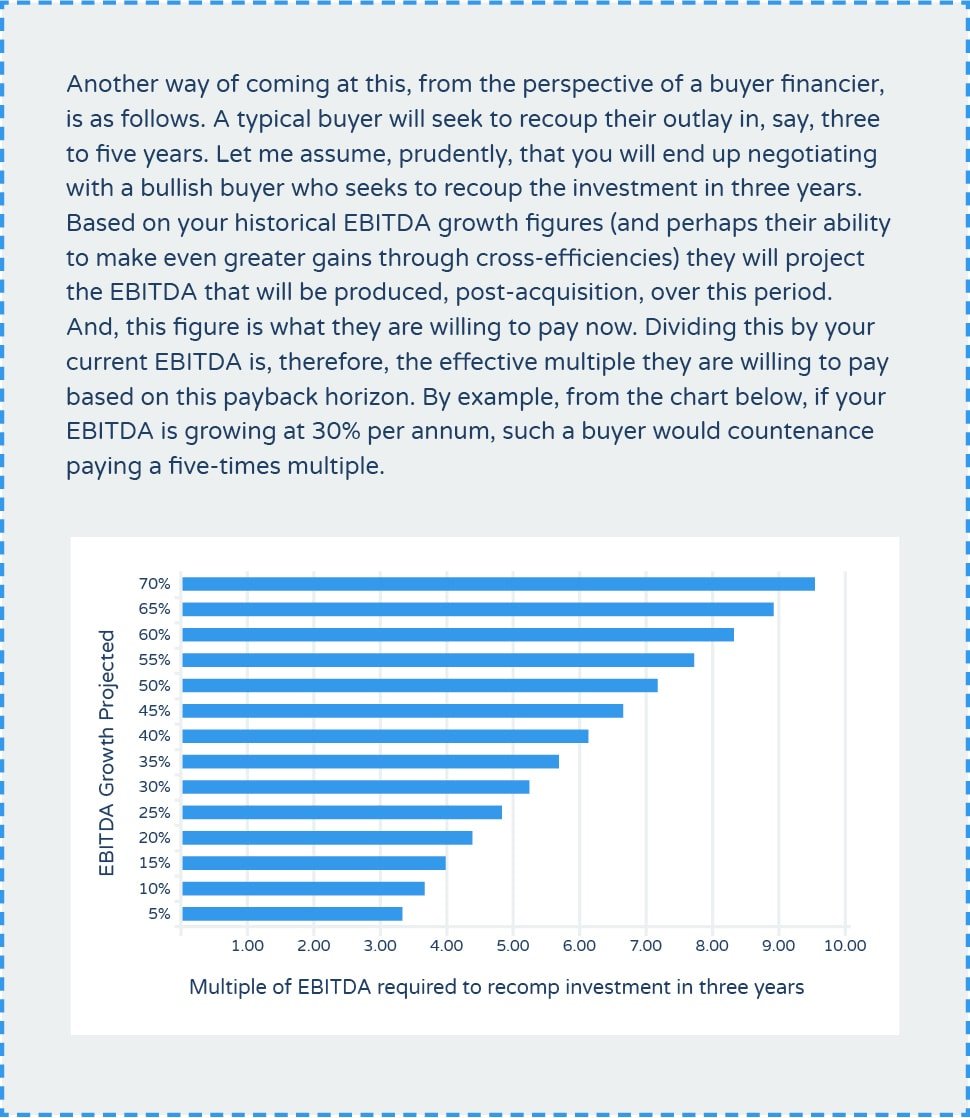Creating optionality - What a buyer seeks - It all starts with growth - What makes up a multiple? - The balancing act
So, if you read last week’s blog, you will know that this blog series will seek to impart advice, reflections, practical “top tips” and case studies to the professional service firm entrepreneur or senior leader. Put another way, I intend to impart my perspective on: How to build an awesome professional service firm (and enjoy the journey en route!).
It makes sense, in this context, to start with some fundamentals; specifically, to ask: what makes a professional services organisation awesome or valuable?
So, ‘Valuation of a professional services firm’ is the subject of this week’s blog – as understanding this topic sets the sails for all subsequent decisions a successful PS firm entrepreneur needs to make.
Valuation of a professional services firm
Before we unpack this together – two super important health warnings.
Firstly, all of these musings on value are for nought if you aren’t, first and foremost, obsessed with bringing tremendous and consistent value to your clients in the services you deliver. Only when you can honestly claim this – as gauged by your clients – does it make sense to explore the topic of organizational value in its broader term.
Secondly, some of what I am about to describe can be seen as somewhat sterile, introspective and financial. Such facts are, however, salient to success. Please don’t infer, however, that this focus on where value lies … prescribes a strategy of building to sale. This is one valid strategy for entrepreneurs but so is that of building a great firm that you stay involved with for your entire career. My writings on value make no pre-judgement as to how owners seek to, ultimately, realise value. Rather, building a valuable firm should be the desire of all rational business leaders – because – valuable firms are ones with sustainable, predictable futures. More so, building value from the perspective of owners is about building optionality into your life; no one knows what the future will bring … so, it always makes sense when facing the unknown to have maximised the value option on such an asset.
With those important points made, let’s turn to some (financial) valuation basics. Company valuations can take multiple forms – ranging from asset pricing, liquidation or book estimate, the discounted modelling of future income streams through to sector-specific rules of thumb.
When it comes to professional service businesses, however, one mechanism dominates. Simply put …
The valuation of professional services firms is driven by the expectation of future profit.
That is, a buyer is primarily interested in the total amount of owner benefit they can extract in the future based on a business’ historical trading performance and its current organisational capabilities. As such, the most common valuation method is a variant of:
Profit x Multiple
Typically, the value used for profit in this equation is:
EBITDA x Multiple
Where EBITDA stands for Earnings before Interest, Tax, Depreciation and Amortisation. In reality, there is often little by the way of asset depreciation and amortisation in a typical professional services firm, so you will also see common reference to the simpler EBIT (‘Earnings before Interest and Tax’) variant.
Valuation analysts might also look at the headline revenues of sold businesses but this is typically only done as a crude proxy when they do not have access to all the financial detail … and suspect that the reported earning figures are not an accurate representation of actual levels of discretionary cash flow. By example, the owner of a business may take a chunk of discretionary cash flow out in the form of a bonus above the profit line. This would artificially depress any reported EBITDA figure which, in turn, would lead to a very high multiple figure. Looking outside-in on such transactions, and not being privy to all of the adjustments used to normalise profit, it is often safer to examine the revenue multiple also – being as it is far less prone to such tinkering.
In relation to your business, however, and with regards as to how a valuation will actually take place: a prospective buyer will be EBITDA obsessed – seeking to get access to a true, or normalised, figure (for the last twelve months typically).
With this established, a critical negotiation as to the multiple will then commence.
A simple way of interpreting such a multiple is that it reflects the number of years a buyer would have to own a business in the future, trading at its current levels of profit performance, before their initial purchase outlay is recouped.

Key point. A buyer is, however, never expecting static growth and, as such, you are only likely to be involved in any such value negotiation if, and only if, your company has demonstrated multiple years (three at least) of clear profit growth trajectory. A multiple, therefore, is far more an indication of the quality of a company’s trading competence.
Understanding, how this quality attribution is made, in the mind of a typical PS firm buyer, is absolutely critical.
Please send me
The most important equation a business leader need ever know
Or, what truly motivates people at work?

For now, let me just give the headlines as, over the coming weeks, this blog series will unpack much of the detail. The essence of a multiple is the degree to which a buyer can trust future profitability expectations; put another way, the degree to which (as a function of how well built your firm is) such future forecasts are derisked. If that is the essence, the more systematic assessment of a multiple will be based on the following:

Now you have an understanding of value – as made up of a focus on profitable (EBITDA) growth and the many qualitative aspects of a multiple, here’s a question:
In that your objective should be to maximise this compound value, but your management time is finite, on what side of the EBITDA x Multiple equation should you focus (or is it just a case of even distribution)?
Well, of course, consistent and sustainable EBITDA growth is a priority. You will never generate a value option if you can’t demonstrate this. But, and it is a mighty big but, within reason.
As soon as you are achieving healthy levels of year-on-year profit growth (say 20% or greater), you are very likely to be better off deliberately shifting your time and effort towards the multiple (or quality) aspect: as far greater gains to overall value can be made here.
This is a simplification but it is a really useful one to make at the heart of everything you do. Once healthy profit growth is established, leaders should focus on developing the elements of the business that make this truly sustainable. You will only be able to grow revenue and profit so fast (indeed, you may damage your business by growing too quickly) but you can make significant strides in the more elastic aspect of your company’s multiple value with focused attention as to your organisational architecture and capabilities.
Hopefully, you now understand the mechanisms for the valuation of a professional services firm and you now have an indication as to the type of areas this blog series will cover in helping you build an awesome professional service business (and enjoying the journey en route).
So, what’s next?
Next up in the series, I am going to describe some recent (and fascinating) research I conducted into what really separates the best companies from the mediocre masses. Without giving it all away (as a promise: you will hear about the most important equation a business leader need ever know) … we are going to explore the importance of teams. Leaders build teams. And teams build awesome companies. So let’s start there.
Hopefully, you’ll join us on this journey. It’s totally free, and you don’t have to be a Method Grid customer (though you’re more than welcome to sign up for a free trial here).
We’ll be releasing a new post each week, starting with the one outlined above. To get each post emailed to you as soon as it’s published, sign up for the Climbing Mount Audacity mailing list below.
Climbing Mount Audacity…
From Startup to Scaleup!
We're sharing everything we know about how to build an awesome professional service firm (and enjoy the journey en route!) PLUS travel updates, reflections on our stumbles and general musings on our Method Grid journey.
Signup below to get the latest articles
direct to your inbox.
See you next week. Have something you want to hear more about? Let me know in the comments below or via Twitter.

 Project and Program Management
Project and Program Management  Project Governance Framework
Project Governance Framework  Benefits Management Framework
Benefits Management Framework 






